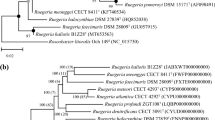Abstract
A Gram-stain-positive, aerobic, non-motile, non-spore-forming, and rod-shaped bacterium, designated strain CHu64-6-1T, was isolated from a 67-cm-long sediment core collected from the Daechung Reservoir at a water depth of 17-m in Daejeon, Republic of Korea. Comparative 16S rRNA gene sequence studies placed the new isolate in the class Sphingobacteriia, and the isolate is notably most closely related to Flavihumibacter sediminis CJ663T (98.1% similarity), Flavihumibacter solisilvae 3-3T (97.8%), Flavihumibacter petaseus T41T (97.5%), Flavihumibacter cheonanensis WS16T (97.4%), and Flavihumibacter stibioxidans YS-17T (97.2%). The cells of strain CHu64-6-1T formed yellow colonies on R2A agar and contained MK-7 as the only menaquinone, phosphatidylethanolamine, an unidentified phospholipid, and two unidentified aminolipids as the major polar lipids, and C15:0 iso, C17:0 iso 3-OH, C15:1 iso G, and C16:1ω5c as the major fatty acids (> 5%). The DNA G + C content of the genome was determined to be 46.5 mol%. The DNA-DNA hybridization values of strain CHu64-6-1T with F. sediminis CJ663T, F. solisilvae 3-3T, F. petaseus T41T, F. cheonanensis WS16T, and F. stibioxidans YS-17T were 12.4–33.2%. Based on the combined genotypic and phenotypic data, we propose that strain CHu64-6-1T represents a novel species of the genus Flavihumibacter, for which the name Flavihumibacter profundi sp. nov. is proposed. The type strain is CHu64-6-1T (= KCTC 62290T = CCTCC AB 2018060T).
Similar content being viewed by others
References
Ezaki, T., Hashimoto, Y., and Yabuuchi, E. 1989 Fluorometric deoxyribonucleic acid-deoxyribonucleic acid hybridization in microdilution wells as an alternative to membrane filter hybridization in which radioisotopes are used to determine genetic relatedness among bacterial strains. Int. J. Syst. Bacteriol. 39, 224–229
Felsenstein, J. 1981 Evolutionary trees from DNA sequences: a maximum likelihood approach. J. Mol. Evol. 17, 368–376
Felsenstein, J. 1985 Confidence limit on phylogenies: an approach using the bootstrap. Evolution 39, 783–791
Fitch, W.M. 1971 Toward defining the course of evolution: minimum change for a specific tree topology. Syst. Zool. 20, 406–416
Hall, T.A. 1999 BioEdit: a user-friendly biological sequence alignment editor and analysis program for Windows 95/98/NT. Nucl. Acids Symp. Ser. 41, 95–98
Han, Y., Zhang, F., Wang, Q., Zheng, S., Guo, W., Feng, L., and Wang, G. 2016 Flavihumibacter stibioxidans sp. nov., an antimony-oxidizing bacterium isolated from antimony mine soil. Int. J. Syst. Evol. Microbiol. 66, 4676–4680
Jin, L., Ko, S.R., Ahn, C.Y, Lee, H.G., and Oh, H.M. 2016 Rhizobacter profundi sp. nov., isolated from freshwater sediment. Int. J. Syst. Evol. Microbiol. 66, 1926–1931
Jin, L., Lee, C.S., Ahn, C.Y., Lee, H.G., Lee, S., Shin, H.H., Lim, D., and Oh, H.M. 2017 Abundant iron and sulfur oxidizers in the stratified sediment of a eutrophic freshwater reservoir with annual cyanobacterial blooms. Sci. Rep. 7, 43814
Kim, W.H., Lee, S., and Ahn, T.Y. 2014 Flavihumibacter cheonanensis sp. nov., isolated from sediment of a shallow stream. Int. J. Syst. Evol. Microbiol. 64, 3235–3239
Komagata, K. and Suzuki, K.I. 1987 Lipid and cell wall analysis in bacterial systematics. Methods Microbiol. 19, 161–207
Lane, D.J. 1991. 16S/23S rRNA sequencing, pp. 115–176 In Stackebrandt, E. and Goodfellow, M. (eds.), Nucleic acid techniques in bacterial systematics. Wiley, Chichester, UK.
Lee, D.H. and Cha, C.J. 2016 Flavihumibacter sediminis sp. nov., isolated from tidal flat sediment. Int. J. Syst. Evol. Microbiol. 66, 4310–4314
Lee, H.J., Jeong, S.E., Cho, M.S., Kim, S., Lee, S.S., Lee, B.H., and Jeon, C.O. 2014 Flavihumibacter solisilvae sp. nov., isolated from forest soil. Int. J. Syst. Evol. Microbiol. 64, 2897–2901
Saitou, N. and Nei, M. 1987 The neighbor-joining method; a new method for reconstructing phylogenetic trees. Mol. Biol. Evol. 4, 406–425
Tamaoka, J. and Komagata, K. 1984 Determination of DNA base composition by reverse-phased high-performance liquid chromatography. FEMS Microbiol. Lett. 125, 125–128
Tamura, K., Stecher, G., Peterson, D., Filipski, A., and Kumar, S. 2013. mega6: molecular evolutionary genetics analysis version 6.0 Mol. Biol. Evol. 30, 2725–2729
Tarrand, J.J. and Groschel, D.H.M. 1982 Rapid, modified oxidase test for oxidase-variable bacterial isolates. J. Clin. Microbiol. 16, 772–774
Thompson, J.D., Gibson, T.J., Plewniak, F., Jeanmougin, F., and Higgins, D.G. 1997 The Clustal X windows interface: flexible strategies for multiple sequence alignment aided by quality analysis tools. Nucleic Acids Res. 24, 4876–4882
Tindall, B.J. 1990 A comparative study of the lipid composition of Halobacterium saccharovorum from various sources. Syst. Appl. Microbiol. 13, 128–130
Wayne, L.G., Brenner, D.J., Colwell, R.R., Grimont, P.A.D., Kandler, O., Krichevsky, M.I., Moore, L.H., Moore, W.E.C., Murray, R.G.E., Stackebrandt, E., et al. 1987 International committee on systematic bacteriology. Report of the ad hoc committee on reconciliation of approaches to bacterial systematics. Int. J. Syst. Bacteriol. 37, 463–464
Yoon, S.H., Ha, S.M., Kwon, S., Lim, J., Kim, Y., Seo, H., and Chun, J. 2017 Introducing EzBioCloud: A taxonomically united database of 16S rRNA and whole genome assemblies. Int. J. Syst. Evol. Microbiol. 67, 1613–1617
Zhang, N.N., Qu, J.H., Yuan, H.L., Sun, Y.M., and Yang, J.S. 2010 Flavihumibacter petaseus gen. nov., sp. nov., isolated from soil of a subtropical rainforest. Int. J. Syst. Evol. Microbiol. 60, 1609–1612
Author information
Authors and Affiliations
Corresponding author
Additional information
The GenBank/EMBL/DDBJ accession numbers for the 16S rRNA gene sequence of strain CHu64-6-1T is MF770247.
Supplemental material for this article may be found at http://www.springerlink.com/content/120956.
Electronic supplementary material
12275_2018_7567_MOESM1_ESM.pdf
Maximum-Parsimony (A) and Maximum-Likelihood (B) trees based on 16S rRNA gene sequences showing positions of strain CHu64-6-1T and related taxa. Only bootstrap values (expressed as percentages of 1,000 replications) greater than 50% are indicated at nodes.
Rights and permissions
About this article
Cite this article
Ren, TT., Jin, CZ., Jin, FJ. et al. Flavihumibacter profundi sp. nov., isolated from eutrophic freshwater sediment. J Microbiol. 56, 467–471 (2018). https://doi.org/10.1007/s12275-018-7567-8
Received:
Revised:
Accepted:
Published:
Issue Date:
DOI: https://doi.org/10.1007/s12275-018-7567-8




